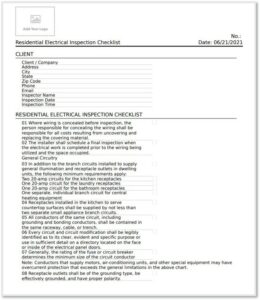Simple Guide to Electrical Inspection Checklists
A checklist is essential for keeping everything organized. It’s a useful tool for task management, project management, and workflow optimization. Investing in checklist apps can be a game-changer for enhancing your productivity. Thanks to advancements in technology, you can today leverage mobile devices (Apple/iOS or Android devices) with customizable checklists for specific purposes, such as an electrical inspection checklist.
An electrical inspection checklist app allows you to start from templates and customize them to suit your needs. You can input due dates, automate tasks, create subtasks, collaborate with co-workers, and take advantage of other advanced features.
What is the purpose of an electrical inspection checklist?
An electrical inspection checklist serves numerous purposes. When buying a new home, you must ensure that the electrical wiring is not faulty or dangerous. An electrical inspection checklist can help you verify the safety of the electrical installation. A licensed electrician can use an inspection checklist to verify the health of the electrical wiring. If you did major home renovations with the potential to change the configuration of your electrical components, it’s vital to have an electrical inspection done. The same applies if you’re adding a new home appliance or replacing an existing one.
Additionally, periodic electrical inspections of an older house ensure that the electrical system is functioning properly. Homes built before 1940 may have outdated lighting technologies, such as knob-and-tube lighting. By conducting an electrical inspection, you can know whether or not to replace obsolete fixtures and whether they are working as they should.

Benefits of electrical inspections
Having an electrical inspection saves you money by reducing electricity bills each month. Through an electrical inspection, your electrician can easily tell if your current electrical system is inefficient. This is particularly true for older houses with knob-and-tube wiring. Upgrading your electrical wiring will not only cut your monthly electricity spending but also help reduce your carbon footprint.
Other benefits of conducting an electrical inspection include:
1. Avert potential hazards
The primary purpose of an electrical code is to ensure safety. Having a licensed electrician inspect your home’s wiring helps prevent hazards such as electrical fires. It also ensures that your home’s electrical wiring is functioning correctly. It’s a reassurance that no mistakes were made during the installation, preventing future mishaps due to faults with your electrical system. System malfunctions and fires are the most common threats posed by faulty electrical components.
2. Compliance with electrical codes
Electrical inspections ensure that your house is not in violation of any federal or local electrical codes. Most local electrical codes follow the National Electrical Code (NEC) implemented by the National Fire Prevention Association (NFPA). When national and local codes conflict, the local code typically takes precedent over the federal code. A local electrician should be well-versed with your local electrical codes and should be able to tell whether or not your home’s electrical system is violating any local or national code.
Who uses an electrical inspection checklist?
Electrical inspectors, property managers, and property owners can use an electrical inspection checklist to execute electrical system inspections for residential or commercial properties. The key purpose of the checklist is to ensure that the electrical system complies with NEC electrical safety guidelines. It also helps identify any electrical hazards such as electrical fires. Besides, you can use the checklist to check whether the equipment is in correct condition and working as it should.
What is checked during an electrical inspection?
An electrical inspection checklist includes the items that ensure your home or workplace adheres to National Electrical Code electrical safety standards. It’s a guidance document that helps in conducting electrical safety inspections for any property. The NFA 70 or NEC is a standard for the safe installation of any electrical wiring or equipment in the U.S. It’s published by the National Fire Protection Association (NFPA). During an electrical inspection, the following parameters of your electrical wiring are checked:
1. Electrical meter
During an inspection, your electric meter will be checked for possible defects. Other than ensuring the electrical meter is logging the correct wattage, your electrician will also check if the meter is installed properly or if its mechanisms have become defective over time due to wear and tear. Your electrician will also look out for rust and other signs of water damage. If there is a leakage, water can easily seep from the meter through to the main electric panel.
2. Check the circuit breaker capacity
Another critical step during an electrical inspection is to check whether or not the circuit breaker is working as designed. Your electrician will also check if the circuit is at risk of overload, an integral consideration for electrical safety. Electricians primarily inspect if the circuit breaker can maintain electrical currents at safe levels. Additionally, they can determine if there is any water damage, corrosion, or structural and mechanical issues that might trigger sparks or fires.
3. Inspect electrical wires for damage or fraying
Electrical wires that are fraying, dangling from walls or ceiling, popping out of their protective coating, or exposed to damp or wet areas can pose hazards. Your electrician should look out for such issues and make the necessary adjustments. They should not leave any space unexamined but check all wires encased in plain sight and those looped through tight nooks and crannies. Where wiring could become unsafe, the electrician should recommend the right fixes.
4. Ensure that GFCI outlets are wired correctly
Ground fault circuit interrupters (GFCIs) are electrical devices installed on power outlets to cut appliances off from the power supply whenever there are irregularities. These irregularities may include water or moisture infiltrating the outlet or strange objects other than plugs. Overall, GFCIs are essential to home safety. Your electrician will double-check that these devices are in correct working order.
Software and forms for electrical inspection checklists
An electrical inspection checklist app or software simplifies the whole process of electrical inspections. It enables electricians to quickly and efficiently conduct routine electrical inspections using mobile devices rather than regular pen and paper. You can use the app to take pictures that are automatically linked to the inspection record to document all system issues and share the results in real-time.

Check out GoCanvas’s free templates for electrical inspections. Schedule time with one of our product experts to see what GoCanvas can do for your business.

Stay in Touch!
About GoCanvas
GoCanvas® is on a mission to simplify inspections and maximize compliance. Our intuitive platform takes care of the administrative tasks, freeing our customers to focus on what truly matters – safeguarding their people, protecting their equipment, and delivering exceptional quality to their customers.
Since 2008, thousands of companies have chosen GoCanvas as their go-to partner for seamless field operations.

Check out even more resources

Improving Your Operations with Field Service Management Software
Whether you have two or 200 employees, your business’ success depends on their hard work. Passionate, motivated team players are the difference between…

Should You Connect Field Service Management Software with QuickBooks?
Field service management software has shown to increase productivity both for employees in the field and operations teams in the office. You may be wondering how field service…

How the Best Field Services Businesses Use Mobile Apps
Mobility and field service: the talk has been happening forever. The idea that real-time information improves customer service and boosts technician productivity is changing…